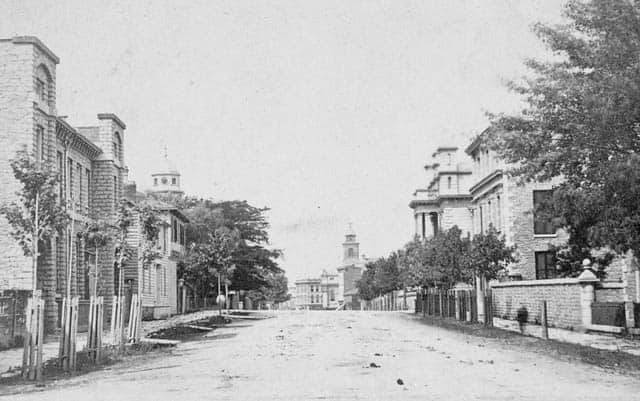In 1842, renowned author Charles Dickens was travelling throughout North America. His works were proving to be popular on this side of the Atlantic Ocean, so much so that fellow author, Washington Irving, invited him to visit. Dickens planned to meet with magazine publishers, who had been using his stories without payment. After a tour of the United States, he decided to head north and visit Upper and Lower Canada.
His first stop was in Niagara, and as he came across the border, he was excited to be back in British territory. He enjoyed Niagara Falls immensely, spending a total of 10 days there before he moved on to Toronto. From Toronto, he took a steamship to Kingston. He stepped off the ship with his wife, Catherine, on the morning of May 7th.
At the time, Kingston was the capital of Upper Canada. As the seat of government, Dickens assumed it would be an important and prosperous town. In his view, it was just the opposite. He later published a log of his travels, and his writings about Kingston were far from kind. He wrote, “[Kingston], now the seat of government in Canada, is a very poor town, rendered still poorer in the appearance of its market-place by the ravages of a recent fire.”
Kingston was indeed recovering from a fire. April 18th, 1840 was a particularly windy night in the Kingston harbour. Steamships moored along the waterfront were being violently tossed about and the captain of one ship ordered his crew to fire up the boilers to head out to deeper, calmer water. As the boilers ignited, sparks from the ship’s funnel blew on to the roof of a nearby warehouse, setting it ablaze.
The fire quickly spread to another warehouse where nearly one hundred kegs of gunpowder were being improperly stored! The resulting explosion broke half the windows in town, blew open the doors along Brock street and threw people off their feet and down the block. Within a four block radius only four buildings were left standing. Remarkably, no one was killed.
It took a long time to rebuild the city, as building with wood was outlawed in the centre of town. Kingston had started to redesign its core in locally quarried limestone when Dickens came through town. He remarked that “one half of [the city] appears to be burnt down, and the other half not to be built up.”
He also judged the location of the city, and while he praised Fort Henry for its construction, he thought that “the town is much too close to the frontier to be long held, I should imagine, for its present purpose in troubled times.”
One thing Dickens loved about Kingston was its prison. He took a tour of Kingston Penitentiary, which had only opened a few years earlier in 1835. At the time, the Penitentiary was known for its strict and brutal treatment of its prisoners. It’s likely Dickens didn’t witness the assaults, lashings and violence brought upon those imprisoned there, including the children. As a man who was vocal about his opposition to solitary confinement, he’s unlikely to have given such a glowing review to the prison if he had seen the real treatment of the incarcerated. He wrote, “There is an admirable jail here, well and wisely governed, and excellently regulated.”

In Dickens’ time, as today, Kingston Pen leaves a lasting impression. (1890)
Dickens stayed three short days in Kingston before carrying on northeast to Montreal. We truly wonder what he’d think of the city we love today. Sadly, that was his only trip to the city – he died in 1870 at age 58. He never got the money owed to him by those North American magazines.
Want to learn more about the secrets of Kingston’s past? Be sure to join us on our new BUBBLE GHOST TOURS in Kingston! A safe and fun way to get some fresh air and enjoy some great ghost stories.

